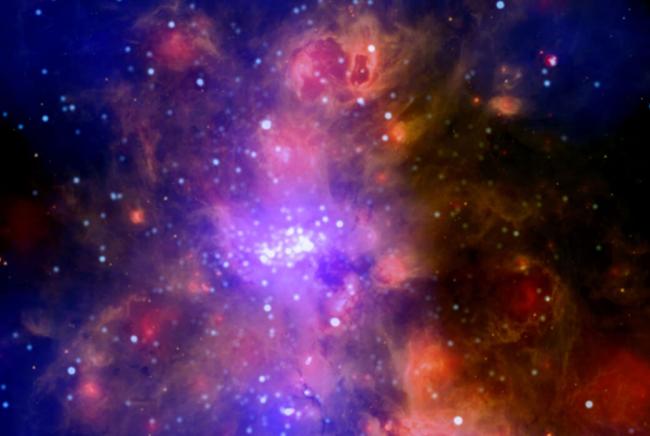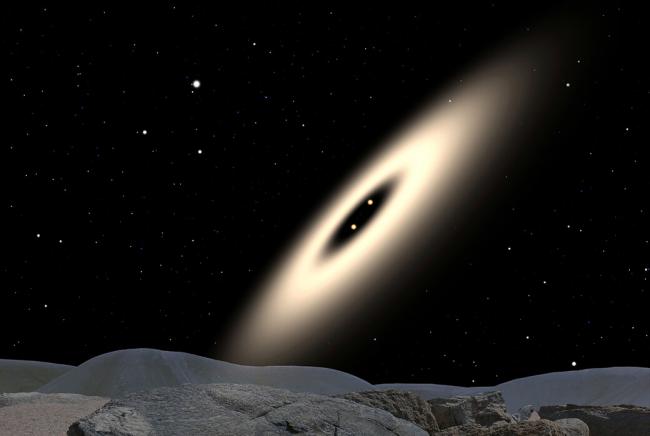How do stars and planets form and evolve?
Everything you’ve ever seen or experienced on Earth was once a nebulous collection of floating gas and dust. Science is starting to understand how those particles came to take the forms you recognize today, teaching us about Earth’s primordial history and guiding our search for extraterrestrial life.
Our Work
Asteroids are time capsules, remnants from the era of planet formation. The same chemical makeup of the protoplanetary disk has been immaculately preserved in an asteroid and offers a trove of information about the early Solar System. Center for Astrophysics | Harvard & Smithsonian scientists are working on the Origins, Spectral Interpretation, Resource Identification, Security, Regolith, Explorer (OSIRIS-REx), which is currently on its way to the asteroid Bennu. Once in orbit around the asteroid, OSIRIS-REx will spend several months analyzing the surface before collecting a surface sample and returning to Earth.
Protostars are so embedded in their cloud of gas and dust that traditional optical telescopes cannot find them. By observing at lower energy wavelengths, the Submillimeter Array (SMA) is able to peer through the clouds and explore these young stars. Astronomers are using the SMA to study dense cores before the onset of star formation and to probe the disks and dynamics of protostars.
Likewise, the X-rays that young stars give off can also penetrate the gas and dust. Young stars shine brighter in X-rays than older stars which can be used to identify the young stars in a sample. CfA scientists use NASA’s Chandra X-ray Observatory, along with other other observatories, to study the survival time of protoplanetary disks and how the stars affect planets in their earliest stages of formation.
Chandra is also essential to study the death of stars. Supernova remnants and the elements they produce generate extremely high temperatures — millions of degrees — even thousands of years after the explosion. Chandra is able to gather detailed information about the elements that supernovae spread throughout the Universe. Many of the elements needed for life were created in a supernova.
The CfA’s Institute for Theory and Computation studies the dynamics of star birth and death by running computer simulations. They find a complex interplay between gravity pulling material toward the young star and radiation pressure pushing it out. Gas and dust form a circumstellar disk that continually accretes onto the star. But as more material falls onto the star, it heats up and ionizes the surrounding gas. This intense heat and light pushes material outwards, limiting the accretion from the disk. Simulations reveal the star channels this energy in the form of outflows near the poles, allowing material to continually feed the star via the disk. This shows how some of the most massive stars in the Universe form.
Though we can’t hit rewind on our own Sun and Earth to see how they originated, we can test observations and theoretical developments against the results we see in our own Solar System. Our scientists probe the task from all sides—from observation of the dense cloud cores and circumstellar disks of matter that serve as the incubators of star and planet formation, to the development of fine-tuned computer modeling of supernova.
Clues From Our Past
In cosmic phenomena, we see echoes of our distant past. Massive clouds of gas and dust condense into centralized protostars, that in turn emit powerful solar wind and bursts of radiation. A newborn star emerges from its molecular cloud nursery. Material left over from the star’s formation collapses into protoplanets.
Each of these observations—now happening at an accelerating pace due to technological developments—offer a tantalizing glimpse into a shared history that’s still being pieced together.
Learning about the processes behind star and planet formation may unlock insight into more than just our own past. Scientists believe the initial composition of the protoplanetary disk could populate a planet with organic molecules. Ultraviolet light from a protostar might then produce the prebiotic chemistry essential to the development of life. X-rays from host stars can irradiate any unprotected life and strip away planetary atmospheres. Identifying these processes could narrow and define the search for life elsewhere in the Universe.

The giant molecular cloud W51 is about 17,000 light-years from Earth. Clouds like this serve as a nursery for newborn stars and planets.
Looking to our Future
Stars follow different paths as they age, determined by their mass, with the most massive burning their fuel exponentially faster.
Smaller stars, like our Sun, live long lives. As they start to run out of hydrogen fuel in their core, they expand and turn red, becoming red giants. The byproducts of fusion collect in the core and, if the star is massive enough, eventually ignite in a new stage of fusion. At the end of their lives, these stars puff off their outer layers leaving behind the core of the star, known as a white dwarf.
Heavier stars, however, burn through their fuel, and the subsequent byproducts, much faster than low mass stars. The energy made by the fusion of heavier and heavier elements balanced the star against the force of gravity. These reactions continued until they formed iron in the core of the star. At this point, further nucleosynthesis would consume rather than produce energy, so gravity then caused the star to implode causing a spectacular explosion known as supernova. After a supernova, some stars leave behind a super dense neutron star, while the heaviest stars leave a black hole.
Based on our understanding of stellar evolution, the Sun will start to run out of core hydrogen in about 5 billion years. The Sun will expand, engulfing several of the inner planets, including Earth.
Building Our Knowledge of How Stars and Planets Begin
Our current understanding of how, when, and where stars and planets form and evolve is advanced through theory and observation. Data from current and next-generation telescopes will inform new computational models for stellar and planetary life cycles. These models are refined and may yield new theoretical discoveries which are in turn tested against observable results.

Artistic rendition of the disk of gas and dust in the V4046 Sagittarii system identified by the Submillimeter Array. Researchers have discovered multiple exoplanets in orbit around binary stars; this system shows how such planets might form.
- Solar-Stellar Connections
- Minor Planets and Comets
- Moons and Satellites
- Planet Formation
- Planetary Geology
- Planetary Nebulas
- Solar and Stellar Atmospheres
- Solar System
- Spectroscopy
- Star Clusters
- Star Formation
- Stellar Structure and Evolution
- Variable Stars and Binaries
- Astrochemistry
- Disks
- Exoplanets
- Gravitational Dynamics
- Interstellar Medium and Molecular Clouds
- Jets, Outflows and Shocks
- Solar & Heliospheric Physics
- The Milky Way Galaxy
- Planetary Systems
- Computational Astrophysics
- Stellar Astronomy
- Theoretical Astrophysics
Related News
Chandra X-Ray Observatory Captures Breathtaking New Images
Astronomers Discover Rare Distant Object in Sync with Neptune
Astronomers Find Far-flung “Super Earths” Are Not Farfetched
CfA Scientists Play Important Role in New NASA Mission
Astronomers Announce Largest Collection Of Exocomets Found
Astronomers Detect Missing Ingredient in Cooking Up Stars
Stellar Pyrotechnics on Display in Super Star Cluster
Dandelion Supernova Revealed in 3-D
Giant Magellan Telescope Mount Fabrication Begins
CfA Celebrates 25 Years with the Chandra X-ray Observatory
Projects
AstroAI
DASCH (Digital Access to a Sky Century @ Harvard)
For that reason, the DASCH (Digital Access to a Sky Century @ Harvard) team are working to digitize the plates for digital storage and analysis. The process can also lead to new discoveries in old images, particularly of events that change over time, such as variable stars, novas, or black hole flares.
GMACS
For Scientists
Sensing the Dynamic Universe
SDU Website
Sloan Digital Sky Survey (SDSS)
Coordinated Molecular Probe Line Extinction Thermal Emission (COMPLETE) Survey of Star Forming Regions
From Molecular Cores to Planet Forming Disks (c2d)
Gould's Belt Survey
The Cygnus-X Spitzer Legacy Survey
ANCHORS
Chandra Supernova Remnant Catalog
Telescopes and Instruments
1.2 Meter (48-inch) Telescope
Visit the 1.2-Meter (48 Inch) Telescope Website
1.3 Meter Telescope
Visit the 1.3 Meter Telescope Website
1.5-meter Tillinghast (60-inch) Telescope
CfA Operated (OIR) | Open to CfA Scientists | Active
Visit the 1.5 Meter (60 Inch) Tillinghast Telescope Website
Chandra
Visit the Chandra Website
Giant Magellan Telescope
Visit the GMT Website
Hinode
Visit the Hinode/XRT Website
Interface Region Imaging Spectrograph (IRIS)
Visit the IRIS Website
Kepler/K2
Visit the Kepler/K2 Website
Magellan Telescopes
Visit the Magellan Telescopes Website
MicroObservatory Telescope Network
Visit the MicroObservatory Telescope Network Website
MMT Observatory
Visit the MMT Website
Pan-STARRS-1 Science Consortium
Visit the Pan-STARRS1 Science Consortium Website
Parker Solar Probe
Visit the Parker Solar Probe SWEAP Website
SOFIA (Stratospheric Observatory for Infrared Astronomy)
Visit the SOFIA Website
Solar and Heliospheric Observer (SOHO)
Visit the SOHO/UVCS Website
Solar Dynamics Observatory (SDO)
Visit the SDO Website
Spitzer Space Telescope
Visit the Spitzer Space Telescope IRAC Page
Stratospheric Terahertz Observatory 1&2
Visit the Stratospheric Terahertz Observatory 1&2 Website
Submillimeter Wave Astronomy Satellite
Visit the SWAS Website
The 1.2 Meter Millimeter-Wave Telescope
Visit the MWT Website
The Submillimeter Array - Maunakea, HI
Visit the Submillimeter Array Website